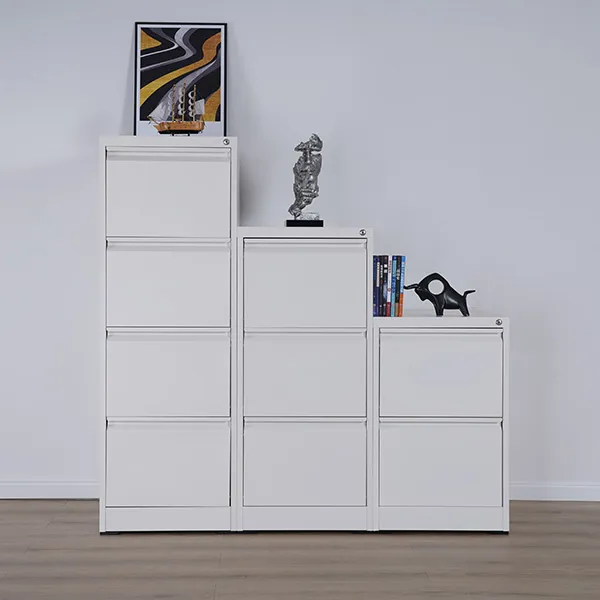Drawer filing cabinets are storage units commonly found in offices and homes to organize and store documents, files, and other paperwork. They typically come in various sizes, ranging from two to five drawers, with each drawer designed to accommodate letter-size or legal-size hanging file folders.
Drawer filing cabinets are often made of metal, wood, or a combination of both materials. Metal cabinets are durable and commonly used in commercial settings, while wooden cabinets are preferred for their aesthetic appeal and blend well with home or office decor.


|
Product Name |
Drawer Filing Cabinets |
|
Material |
Full thickened Cold-rolled Steel |
|
Size |
Refer to Drawer Filing Cabinets Installation |
|
Surface |
Rust & Abrasion-resistant Coating/Electronic Powder Coating |
|
Warranty Period |
3-5 Years |
|
Note |
OEM & ODM accepted |
|
Related Certificates |
ISO9001,ISO14001,OHSAS18001,BV |
|
Usage Scenarios |
Office, school, home, hotel, hospital, company, factory, etc. |
|
Structure |
Knocked down structure, free-standing and convenient to transport |
|
Range |
2/3/4 Drawer Filing Cabinet, Drawer Cabinet |
Locking Mechanism: Many filing cabinets come with a locking mechanism to secure sensitive documents and provide privacy.
Ball-Bearing Suspension: Higher quality cabinets may feature ball-bearing suspension for smooth drawer operation, allowing for easy access to files.
Label Holders: Each drawer typically has a label holder, making it easy to identify the contents stored within.
Anti-Tip Mechanism: To prevent the cabinet from tipping over when multiple drawers are open simultaneously, some models include an anti-tip mechanism for added safety.
Casters: Mobile filing cabinets may have casters attached to the bottom, allowing for easy mobility and repositioning within the office or home.

| CYD-075 (4 Drawers) | H1325 * W460 * D620mm |
|
CYD-076 (3 Drawers) |
H1025 * W460 * D620mm |
|
CYD-077 (2 Drawers) |
H725 * W460 * D620mm |
| CYD-G080 (4 Drawers) |
H1325 * W460 * D620mm |
|
CYD-G081 (3 Drawers) |
H1025 * W460 * D620mm |
|
CYD-G082 (2 Drawers) |
H725 * W460 * D620mm |
|
CYD-G087 (4 Drawers) |
H1570 * W550 * D750mm |
|
CYD-G088 (3 Drawers) |
H1200 * W550 * D750mm |
|
CYD-G089 (2 Drawers) |
H830 * W550 * D750mm |
1. Choose the Location: Decide where you want to place the filing cabinet. Ensure it's on a flat, stable surface and ideally against a wall for stability.
2. Assembly (if required): If your filing cabinet requires assembly, follow the manufacturer's instructions carefully. Typically, this involves attaching wheels or legs, assembling the drawers, and securing the top.
3. Positioning: Place the filing cabinet in its intended location. If it has wheels, ensure they are locked if you want it to stay stationary.
4. Leveling: Use a spirit level to check if the cabinet is level. Adjust as needed by placing shims under the wheels or legs to stabilize it.
5. Securing (optional): If you want extra stability, especially for tall cabinets, consider securing it to the wall using brackets or straps. This prevents tipping, which is important for safety.
6. Testing: Open and close the drawers to ensure they operate smoothly and that the cabinet remains stable.
7. Organizing: Once installed, organize your files or items in the drawers according to your needs.
8. Maintenance: Periodically check the stability and functionality of the cabinet, tightening screws if necessary.


Please Leave Us A Message With Your Questions Or Needs